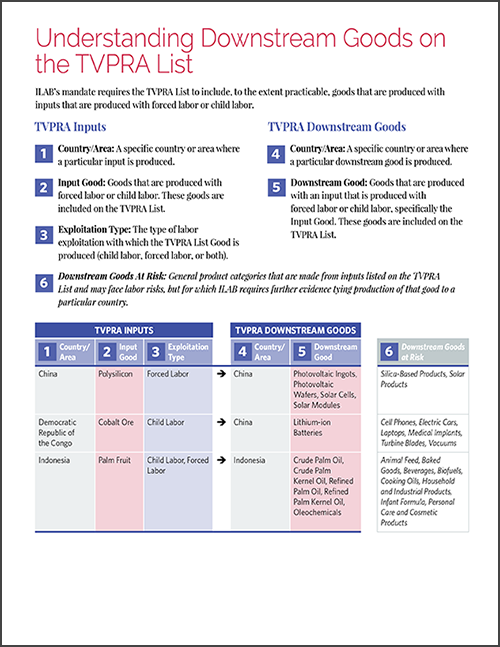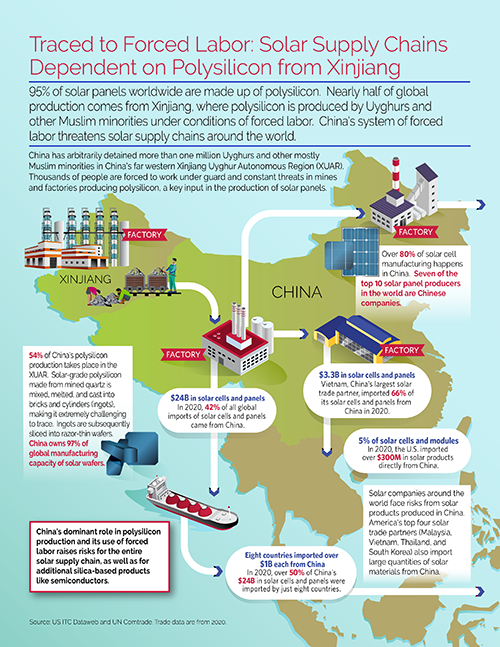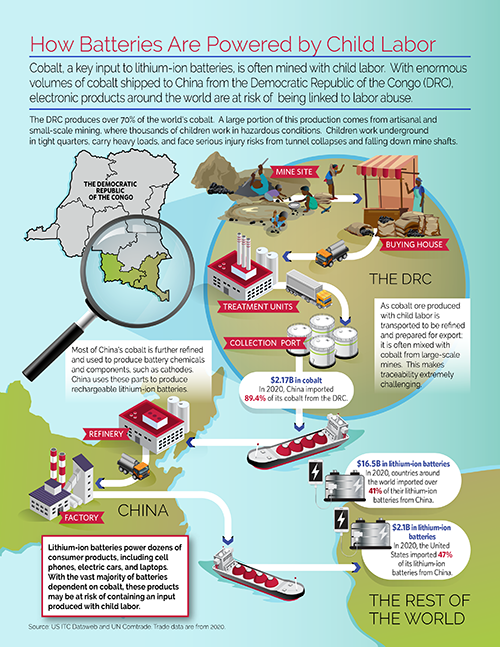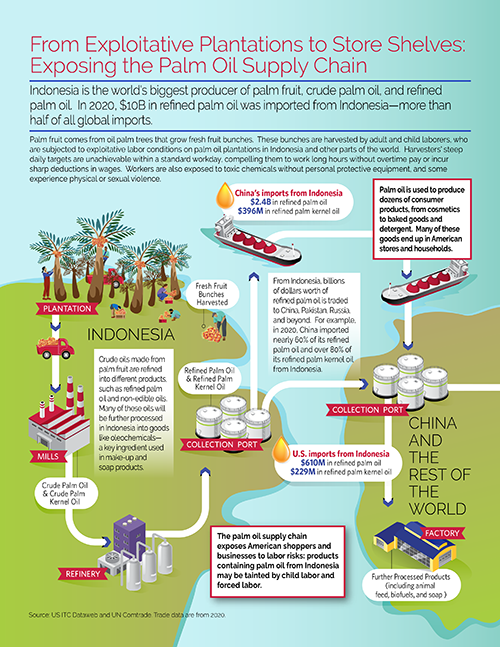Identifying Goods Produced with Inputs Produced with Forced Labor or Child Labor
The Bureau of International Labor Affairs (ILAB) maintains a list of goods and their source countries which it has reason to believe are produced by child labor or forced labor in violation of international standards, as required under the Trafficking Victims Protection Reauthorization Act (TVPRA) of 2005 and subsequent reauthorizations.
The Frederick Douglass Trafficking Victims Prevention and Protection Reauthorization Act of 2018 expanded this mandate to require the TVPRA List to also include, "to the extent practicable, goods that are produced with inputs that are produced with forced labor or child labor."
In response, ILAB's Office of Child Labor, Forced Labor, and Human Trafficking (OCFT) is identifying downstream products containing goods that ILAB has reason to believe are produced with forced labor or child labor and including them on the TVPRA List. In a given country on the TVPRA List, there may be entities that produce listed goods in compliance with the law and international standards, and others that employ child labor or forced labor in their supply chains. ILAB's TVPRA List, as well as supporting supply chain research, can be considered a risk radar used to raise public awareness about forced labor and child labor around the world and to promote efforts to combat them.
Listing goods is intended to serve as a catalyst for more strategic and focused coordination and collaboration among those working to address these problems. ILAB's supply chain research is additionally a valuable resource for advocacy organizations and companies who seek to carry out risk assessments and engage in due diligence on labor rights in their supply chains. This research also provides information for consumers and highlights additional product categories that may be at risk of having inputs produced with forced labor or child labor.
- List of Goods (Full Report) (PDF)
- List of Downstream Goods (Excel)
- List of Goods (Bibliography) (PDF)
ILAB's supply chain research represents one of the first comprehensive efforts to assess goods produced with inputs produced with forced labor or child labor. Consistent with its Procedural Guidelines, ILAB analyzes a wide variety of publicly available primary and secondary sources to conduct the research. In its supply chain research, ILAB also analyzes evidence on production processes and supply chains to ensure a direct correspondence between downstream goods and the use of child labor or forced labor in the production of their inputs.
Learn more about how ILAB is advancing research on exploitation in global supply chains (pgs. 45-59).
| Country/Area | TVPRA Input Good | Exploitation Type | Country/Area | TVPRA Downstream Good | Downstream Goods at Risk* |
|---|---|---|---|---|---|
| Country/Area China | TVPRA Input Good Polysilicon | Exploitation Type Forced Labor | Country/Area China |
TVPRA Downstream Good
Photovoltaic Ingots, Photovoltaic Wafers, Solar Cells, Solar ModulesILAB has reason to believe that multiple solar products produced in China are made with an input using forced labor, specifically from polysilicon produced in China. These products include photovoltaic ingots and wafers (China), solar cells (China), and solar modules (China). Polysilicon was added to ILAB’s List of Goods Produced by Child Labor or Forced Labor in 2021 for forced labor. Forty-five percent of the world’s solar-grade polysilicon and more than half of China’s polysilicon is produced in the Xinjiang Uyghur Autonomous Region, where research has shown it is produced under conditions of forced labor. China has 98 percent of the world's manufacturing capacity for photovoltaic ingots; 97 percent for photovoltaic wafers; 81 percent for solar cells; and 77 percent for solar modules, all of which are made with polysilicon. Many of the largest global producers of photovoltaic ingots and wafers, solar cells, and solar modules directly source polysilicon from entities believed to use forced labor in its production. In 2020, solar cells and modules imported from China accounted for over $24 billion. While the U.S. directly imported about 5 percent of its solar cells and modules from China, it is likely that additional solar cells and modules made with polysilicon produced with forced labor enter the U.S. through other countries. Many solar companies operating around the world have suppliers based in China and many are owned by Chinese companies. Over 42 percent of global imports of solar cells and modules come from China. This research suggests that other downstream products of polysilicon, such as semiconductors, silica-based goods, and solar generators, may be produced with an input produced with forced labor. |
Downstream Goods at Risk* Silica-Based Products, Solar Generators, Semiconductors |
| Country/Area Democratic Republic of the Congo | TVPRA Input Good Cobalt Ore | Exploitation Type Child Labor | Country/Area China |
TVPRA Downstream Good
Lithium-Ion BatteriesILAB has reason to believe that lithium-ion batteries manufactured in China are produced with an input produced with child labor, specifically cobalt ore mined in the Democratic Republic of the Congo (DRC). Cobalt ore from the DRC was added to ILAB’s List of Goods Produced by Child Labor or Forced Labor in 2009 for child labor. Cobalt is used in the production of nearly all lithium-ion batteries. The DRC produces the majority of the world’s cobalt. Most cobalt-producing mines in the DRC are owned or financed by Chinese companies. In 2020, China imported $2.17 billion of cobalt from the DRC. Between 49–80 percent of China’s refined cobalt imports are used to produce battery chemicals and components. Global imports of lithium-ion batteries from China were reported to be over $16.5 billion in 2020. Of the $4.3 billion in lithium-ion battery imports to the United States in 2020, 47.22 percent ($2.1 billion) were imported from China. This research suggests that further downstream products containing lithium-ion batteries may be produced with an input produced with child labor, such as electric cars, laptops, and cell phones. |
Downstream Goods at Risk* Electric Cars, Laptops, Cell Phones, Vacuums, Turbine Blades, Medical Implants |
| Country/Area Indonesia | TVPRA Input Good Palm Fruit | Exploitation Type Child Labor, Forced Labor | Country/Area Indonesia |
TVPRA Downstream Good
Crude Palm Oil, Crude Palm Kernel Oil, Refined Palm Oil, Refined Palm Kernel Oil, OleochemicalsILAB has reason to believe that multiple palm oil products produced in Indonesia are made with an input using child labor and forced labor, specifically palm fruit harvested in Indonesia. These palm oil products include crude palm oil, crude palm kernel oil, refined palm oil, refined palm kernel oil, and oleochemicals. Palm Fruit from Indonesia was added to ILAB’s List of Goods Produced by Child Labor or Forced Labor in 2010 for child labor and added in 2020 for forced labor. Indonesia produces most of the world’s palm fruit and palm oil. In 2020, refined palm oil from Indonesia accounted for 55.26 percent of global imports. In 2020, the U.S. obtained about 60 percent of its $1 billion in refined palm oil imports from Indonesia. This research suggests that further downstream products of palm fruit and palm oil, such as cooking oils, animal feed, bakery items and baked goods, beverages, household and industrial products, personal care and cosmetic products, infant formula, and biofuels, may be produced with an input produced with child labor and forced labor. |
Downstream Goods at Risk* Cooking Oils, Animal Feed, Baked Goods, Beverages, Household and Industrial Products, Personal Care and Cosmetic Products, Infant Formula, Biofuels |
Additional Supply Chain Research
ILAB produces and funds research on child labor and forced labor in global supply chains. Learn more about how goods produced with child labor or forced labor can end up as common products:
Want this report plus over a thousand pages of research in the palm of your hand? Download ILAB's Sweat & Toil App today!
Are you a company looking to fight child labor and forced labor in supply chains? View ILAB's Comply Chain Tool Today!
Related
- List of Goods Produced by Child Labor or Forced Labor
- Findings on the Worst Forms of Child Labor
- Executive Order 13126 List of Products Produced by Forced or Indentured Child Labor
- Against Their Will: The Situation in Xinjiang
Public Comments & Submissions
ILAB accepts public submissions for the TVPRA List on an ongoing basis, and reviews them as they are received. Submissions will continue to be taken into account as ILAB works to release periodic updates to the List. To submit information, please send an email to ILAB-TVPRA@dol.gov; fax to 202-693-4830; or mail to ILAB, U.S. Department of Labor, c/o OCFT Research and Policy Unit, 200 Constitution Ave NW, S-5315, Washington, DC 20210. View the list of submissions.




